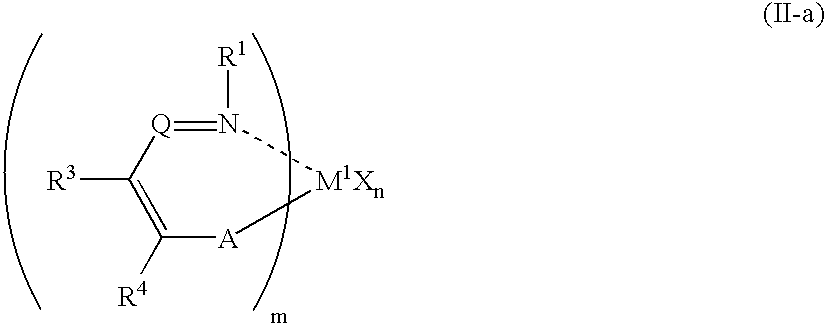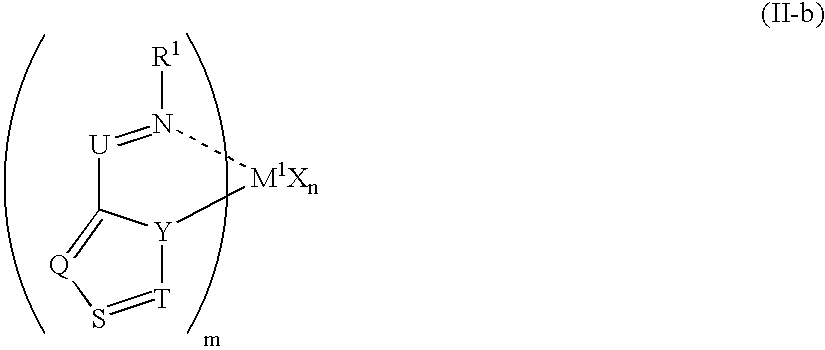Olefin polymer and production processes thereof
a technology of olefin polymer and polymerization process, applied in the field of olefin polymers, can solve the problems of difficult to produce commercially useful polyethylene and ethylene copolymers by living polymerization, and achieve the effect of efficient preparation of such polymers
- Summary
- Abstract
- Description
- Claims
- Application Information
AI Technical Summary
Benefits of technology
Problems solved by technology
Method used
Image
Examples
synthesis example 1
In a 100 ml reactor thoroughly purged with nitrogen, 100 ml of toluene, 10.34 g (56.5 mmol) of pentafluoroaniline, 6.68 g (75.4%, 28.2 mmol) of 3-t-butylsalicylaldehyde and a small amount of acetic acid as a catalyst were placed, and they were heated and refluxed with stirring for 7 hours. After the solution was allowed to stand for cooling, a small amount of p-toluenesulfonic acid was added as a catalyst, and they were refluxed with stirring for 2.5 hours. The reaction solution was allowed to stand for cooling to room temperature, then filtered to remove the catalyst and vacuum concentrated. The residue was purified by a silica gel column to obtain 8.47 g (yield: 88%) of yellow solids represented by the following formula (a).
In a 50 ml reactor thoroughly purged with nitrogen, 1.043 g (3.00 mmol) of the compound (a) obtained above and 30 ml of anhydrous diethyl ether were placed, and the solution was cooled to −78° C. and stirred. To the solution, 2.05 ml of n-butyllithium (n-hexan...
synthesis example 2
In a 200 ml reactor thoroughly purged with nitrogen, 100 ml of toluene, 3.82 g (26.0 mmol) of 2,4,6-trifluoroaniline, 2.32 g (13.0 mmol) of 3-t-butylsalicylaldehyde and a small amount of p-toluenesulfonic acid as a catalyst were placed, and they were heated and refluxed with stirring for 4 hours. The reaction solution was allowed to stand for cooling to room temperature, then filtered to remove the catalyst and vacuum concentrated. The residue was purified by a silica gel column to obtain 3.79 g (yield: 95%) of a yellow oil represented by the following formula (b).
In a 50 ml reactor thoroughly purged with nitrogen, 1.23 g (4.00 mmol) of the compound (b) obtained above and 30 ml of anhydrous diethyl ether were placed, and the solution was cooled to −78° C. and stirred. To the solution, 2.63 ml of n-butyllithium (n-hexane solution, 1.60 N, 4.20 mmol) was dropwise added over a period of 5 minutes, and then the mixture was slowly heated to room temperature. After stirring for 2 hours a...
synthesis example 3
In a 100 ml reactor thoroughly purged with nitrogen, 30 ml of ethanol, 5.16 g (40.0 mmol) of 2,6-difluoroaniline, 3.58 g (20.0 mmol) of 3-t-butylsalicylaldehyde and a small amount of acetic acid as a catalyst were placed, and they were heated and refluxed with stirring. With further adding a small amount of acetic acid, the mixture was refluxed with stirring for 150 hours. The reaction solution was allowed to stand for cooling to room temperature and then vacuum concentrated. The residue was purified by a silica gel column to obtain 4.76 g (yield: 82.2%) of yellow solids represented by the following formula (c).
In a 30 ml reactor thoroughly purged with nitrogen, 1.16 g (4.00 mmol) of the compound (c) obtained above and 20 ml of anhydrous diethyl ether were placed, and the solution was cooled to −78° C. and stirred. To the solution, 2.50 ml of n-butyllithium (n-hexane solution, 1.6 N, 4.00 mmol) was dropwise added over a period of 5 minutes, and then the mixture was slowly heated to...
PUM
| Property | Measurement | Unit |
|---|---|---|
| temperature | aaaaa | aaaaa |
| temperature | aaaaa | aaaaa |
| temperature | aaaaa | aaaaa |
Abstract
Description
Claims
Application Information
 Login to View More
Login to View More - R&D
- Intellectual Property
- Life Sciences
- Materials
- Tech Scout
- Unparalleled Data Quality
- Higher Quality Content
- 60% Fewer Hallucinations
Browse by: Latest US Patents, China's latest patents, Technical Efficacy Thesaurus, Application Domain, Technology Topic, Popular Technical Reports.
© 2025 PatSnap. All rights reserved.Legal|Privacy policy|Modern Slavery Act Transparency Statement|Sitemap|About US| Contact US: help@patsnap.com



